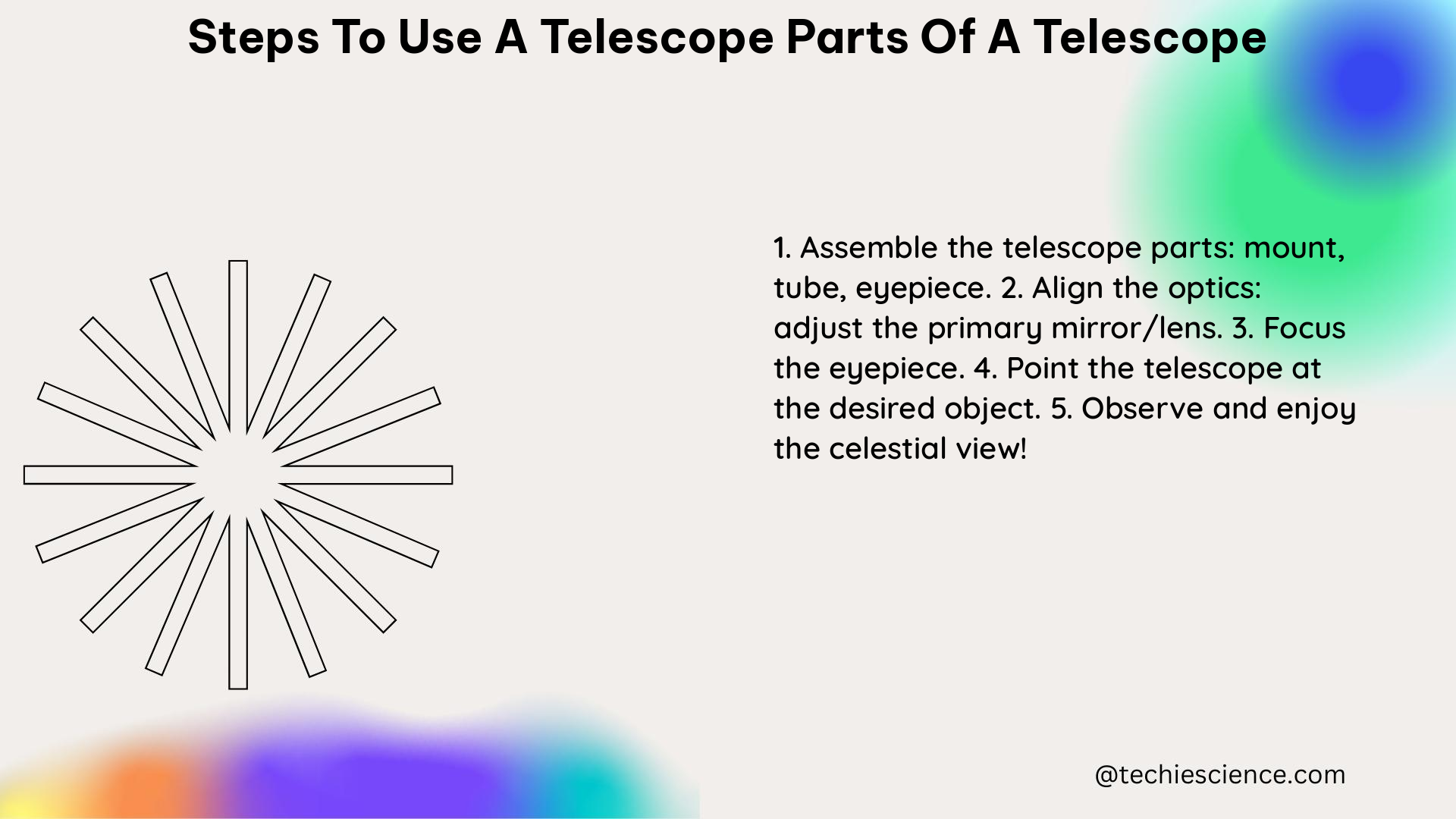Telescopes are powerful tools that allow us to explore the wonders of the universe, from distant galaxies to the intricate details of our solar system. To fully harness the capabilities of a telescope, it’s essential to understand its various components and how to use them effectively. In this comprehensive guide, we’ll delve into the key parts of a telescope and provide a step-by-step approach to using them for optimal observation.
Telescope Types: Unraveling the Differences
Telescopes come in three primary types, each with its own unique characteristics and advantages:
Refractor Telescopes
Refractor telescopes use lenses to gather and focus light. The key parameters to consider are:
Aperture: The diameter of the objective lens, typically measured in inches or millimeters. A larger aperture gathers more light, enabling the observation of fainter celestial objects.
Focal Length: The distance between the lens and the point where the light converges, usually measured in millimeters. This determines the telescope’s magnification power.
Reflector Telescopes
Reflector telescopes use mirrors to gather and focus light. The critical factors are:
Aperture: The diameter of the primary mirror, which determines the light-gathering capability.
Focal Length: The distance between the primary mirror and the point where the light converges.
Catadioptric Telescopes
Catadioptric telescopes combine lenses and mirrors to provide a compact, high-quality image. The relevant parameters are:
Aperture: The diameter of the primary mirror or lens.
Focal Length: The distance between the primary mirror or lens and the point where the light converges.
Understanding these telescope types and their key specifications will help you choose the right instrument for your observational needs.
Eyepieces: The Window to the Cosmos

Eyepieces are essential components that allow you to view the celestial objects captured by the telescope. The focal length of the eyepiece, combined with the telescope’s focal length, determines the magnification power.
Magnification = Telescope Focal Length / Eyepiece Focal Length
For example, a telescope with a 1000mm focal length and a 25mm eyepiece would have a magnification of 40x (1000mm / 25mm = 40).
Choosing the right eyepiece for your observational needs is crucial. A higher magnification may not always be better, as it can reduce the field of view and introduce image distortion. It’s generally recommended to start with a lower magnification eyepiece and gradually increase the power as needed.
Finderscope: Your Celestial Navigation Tool
The finderscope is a low-power telescope attached to the main telescope. It serves as a guide, helping you locate and center celestial objects in the main telescope’s field of view.
To align the finderscope, follow these steps:
- Identify a bright star, planet, or the Moon as your target.
- Use a 26mm eyepiece (or a similar focal length for a reflector telescope) in the main telescope.
- Adjust the finderscope’s adjustment screws until the target object is centered in the finderscope’s view.
This alignment process ensures that the finderscope and the main telescope are pointing at the same celestial object, making it easier to find and track your desired targets.
Telescope Mounts: Stability and Precision
Telescope mounts play a crucial role in providing stability and precision for your observations. There are two primary types of telescope mounts:
Alt-Azimuth Mounts
Alt-Azimuth mounts allow movement in two axes: altitude (up and down) and azimuth (left and right). These mounts are relatively simple to use and are well-suited for casual stargazing.
Altitude: The angle between the telescope and the horizon, typically measured in degrees.
Azimuth: The horizontal direction of the telescope, often measured in degrees from north.
Equatorial Mounts
Equatorial mounts are designed to compensate for Earth’s rotation, making it easier to track celestial objects as they appear to move across the sky. These mounts have two axes:
Right Ascension (RA): The celestial equivalent of longitude, measured in hours, minutes, and seconds.
Declination (Dec): The celestial equivalent of latitude, measured in degrees.
Equatorial mounts require more setup and adjustment, but they offer superior tracking capabilities, making them the preferred choice for astrophotography and serious observational work.
Telescope Accessories: Enhancing Your Observational Experience
In addition to the core telescope components, there are various accessories that can enhance your observational experience:
- Eyepiece Filters: These filters can improve contrast, reduce glare, and enhance the visibility of specific celestial features.
- Barlow Lenses: These accessories increase the effective focal length of the telescope, providing additional magnification without the need for a new eyepiece.
- Diagonal Mirrors: These mirrors redirect the light path, allowing for more comfortable viewing positions.
- Dew Shields and Heaters: These devices prevent dew formation on the telescope’s optics, ensuring clear and unobstructed views.
- Astrophotography Accessories: Items like cameras, adapters, and tracking mounts enable you to capture stunning images of the night sky.
Incorporating these accessories can significantly improve your observational capabilities and unlock new levels of exploration.
Telescope Maintenance and Care
To ensure the longevity and optimal performance of your telescope, it’s essential to properly maintain and care for it. Here are some key considerations:
- Cleaning Optics: Gently clean the objective lens or primary mirror using a soft, lint-free cloth and a specialized optical cleaning solution.
- Collimation: Reflector telescopes require periodic collimation, the process of aligning the mirrors for optimal image quality.
- Storage and Transportation: Store your telescope in a dry, temperature-controlled environment and use a protective case or cover when transporting it.
- Periodic Inspection: Regularly check for any loose or damaged components and address any issues promptly.
By following these maintenance guidelines, you can ensure your telescope remains in top condition, providing you with years of reliable and enjoyable observations.
Conclusion
Mastering the art of using a telescope requires a deep understanding of its various components and how they work together. By familiarizing yourself with the different telescope types, eyepieces, finderscopes, mounts, and accessories, you’ll be well on your way to unlocking the wonders of the cosmos. Remember to always prioritize safety, maintain your equipment, and continuously explore the ever-expanding frontiers of amateur astronomy.
References:
- Telescope Basics: How to Use a Telescope
- Beginner’s Guide to Using a Telescope
- How Telescopes Work
- Telescope Optics and Design
- Telescope Maintenance and Care

Hi, I am Sanchari Chakraborty. I have done Master’s in Electronics.
I always like to explore new inventions in the field of Electronics.
I am an eager learner, currently invested in the field of Applied Optics and Photonics. I am also an active member of SPIE (International society for optics and photonics) and OSI(Optical Society of India). My articles are aimed at bringing quality science research topics to light in a simple yet informative way. Science has been evolving since time immemorial. So, I try my bit to tap into the evolution and present it to the readers.
Let’s connect through